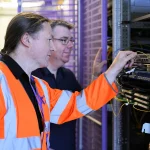AAISP Warns UK Government to Fix Costly Broadband Capacity Before Speed
The Director of UK ISP Andrews & Arnold (AAISP), Adrian Kennard, has warned that the recent focus upon improving the country’s broadband ISP speeds risk neglecting the need for more affordable back-haul capacity to support the new generation of superfast internet access services.
Last week’s House of Lords Select Committee Report into the UK government’s superfast broadband strategy, which aims to make superfast broadband (24Mbps+) services available to 90% of people in the UK by 2015, similarly warned that the plan had become “preoccupied with speed” when it should of been focusing upon the need to create a “future proof national network which is built to last“.
Advertisement
Kennard agrees but notes that the cost of feeding the latest generation of superfast broadband connections (e.g. BT’s 330Mbps capable FTTP service) can be “seriously expensive“, especially when the connection is “only to be filled by one customer“. Add in the need for contention (shared capacity between multiple users) to make such services economically viable and the ability to actually deliver 330Mbps moves from being a home infrastructure problem to a limitation of raw capacity.
Adrian Kennard, Director of Andrews & Arnold, told ISPreview.co.uk:
“I do generally agree that it is odd to have quite such a focus on high speed links. Yes, there is a big difference between [500Kbps (0.5Mbps) and 2Mbps], but when you get to higher speeds there is less and less advantage in practical terms even if people are streaming video (as is increasingly the case). The latest services from BT such as 330Mb/s FTTP are actually a major issue for any small or startup ISP as 330Mb/s back-haul in to BT is seriously expensive, only to be filled by one customer.
For a lot of end users, once they can get over 2Mb/s, the speed of their individual link is not the issue but the speed of access to “the Internet”.”
In fairness the cost of broadband capacity has been coming down for awhile but the new services are, in some cases, a significant order or magnitude faster than the old. This somewhat out ways the declining costs and makes it difficult to ISPs, both big and small alike, to keep pace. Not so long ago a 330Mbps link would have supplied hundreds or possibly even thousands of individual subscribers (e.g. 1Mbps ADSL connections).
Kennard added:
“This comes down to costs of back-haul links across wholesale access networks like BT. If everyone is to be routinely streaming video over these links, that means a lot of investment in making those back-haul links much more cost effective for the ISPs providing the overall service. Some of the ideas in the report seem to be aimed at this very issue, suggesting more open access to local cabinets, but there is still the need to move that data across the country.”
On the other hand the vast majority of home users would have trouble utilising the top speeds anyway, with most internet services restricting their performance to well below the 100Mbps level in order to remain economically viable; capacity is a huge cost for online content providers too.
But we wouldn’t entirely agree with the Lords suggestion that the government has become “preoccupied with speed“. Speed can be used as a measure of infrastructure capability and as a result it’s sometimes important to define an acceptable level in order to ensure that the service being delivered is capable of more. For example, had the government kept to its original target of 20Mbps then that would have opened the door to saying “job done” via existing ADSL2+ (up to 24Mbps) connectivity. Not so good.
Advertisement
Meanwhile today’s aggressively competitive market often pressures ISPs into offering the latest top speeds via new technology and infrastructure, sometimes even when they don’t have the capacity to support it. Ultimately home broadband is still a “Best Efforts” service and as a result, whatever the solution, your top speed must always be shared with others.
In short, it’s important for the country to upgrade its national telecoms infrastructure but we must not forget that the connectivity between ISP and Home User is only half the equation.
Mark is a professional technology writer, IT consultant and computer engineer from Dorset (England), he also founded ISPreview in 1999 and enjoys analysing the latest telecoms and broadband developments. Find me on X (Twitter), Mastodon, Facebook, BlueSky, Threads.net and Linkedin.
« iPass Expands Network to 1 Million Premium Global Wi-Fi Hotspots

















































Comments are closed